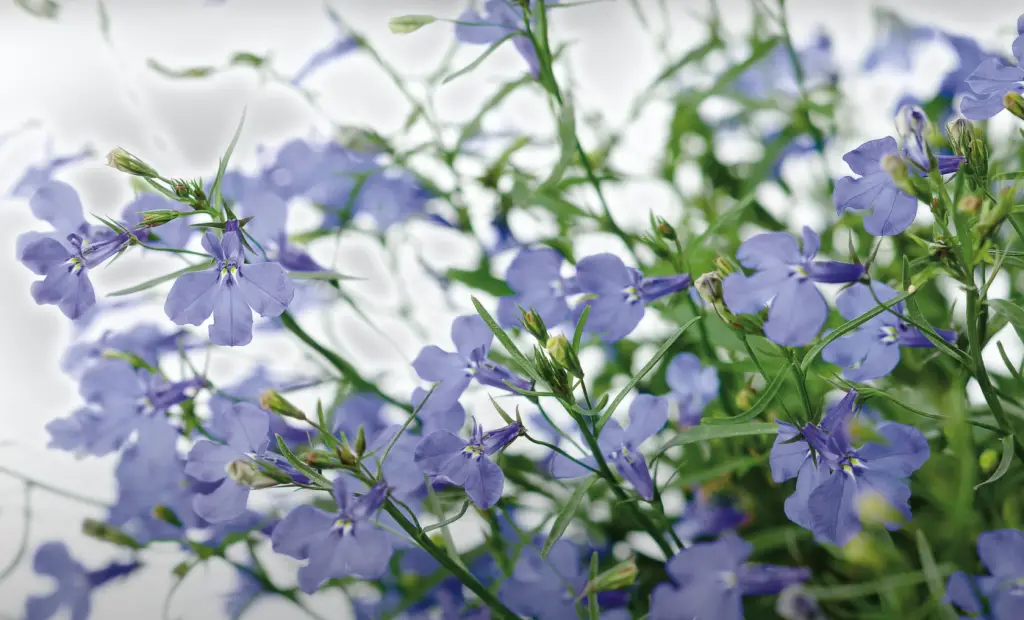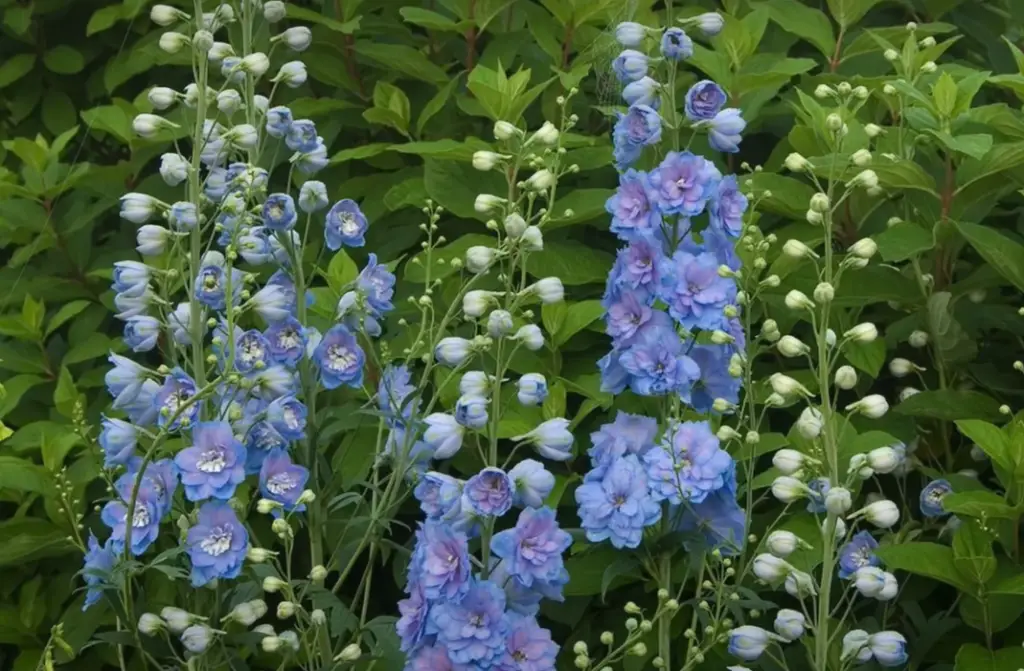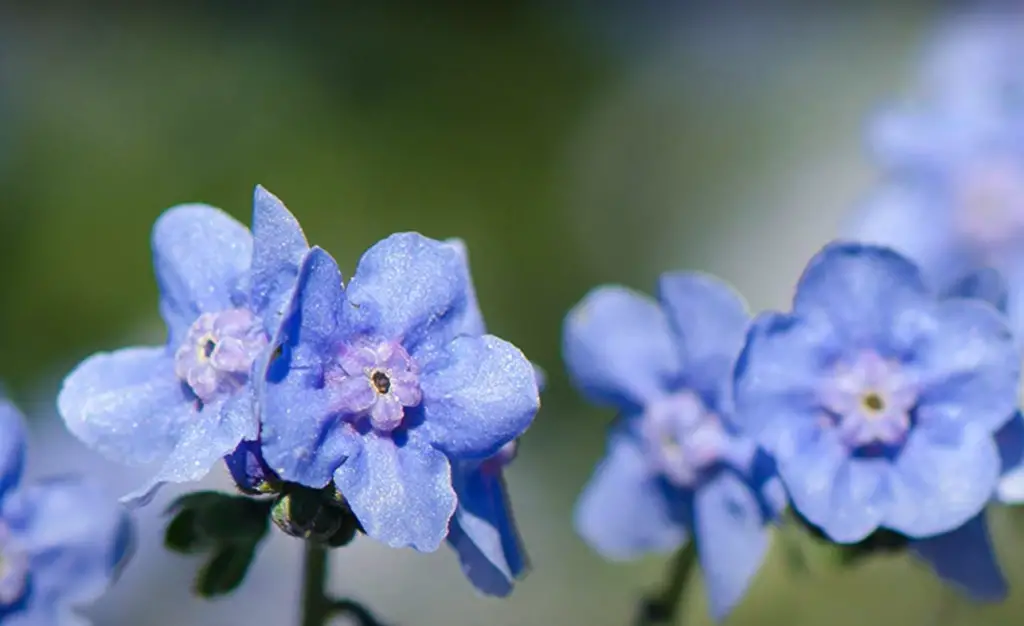Weeds with blue flowers can be beautiful additions to your garden, but they can also spread quickly and take over. It’s important to understand which plants are truly weeds and how to keep them under control in order to maintain a healthy garden. In this article, we’ll answer some frequently asked questions about weeds with blue flowers and provide useful tips for controlling them.
Wild violet (Viola odorata)
Wild violet is a perennial weed with heart-shaped, deep green leaves and fragrant blue blooms. While it has many uses in landscaping, wild violets can spread quickly and choke out other plants in your garden.

To control wild violet, remove the flowers as soon as they appear and mulch heavily around your garden beds to prevent seed germination.[3]
Blueweed (Echium vulgare)
Blueweed is a common weed with an unmistakable blue flower. It’s also known as viper’s bugloss and it’s a member of the borage family.
Meadow cranesbill (Geranium pratense)
Meadow cranesbill is a type of wildflower that has beautiful deep blue flowers. It’s often found in meadows and other grassy areas, but it can also spread to gardens when the conditions are right. This weed thrives in wet, moist soil with plenty of sun exposure, making it difficult to remove from areas where it has become established.
Meadow cranesbill can be identified by its deep blue flowers and divided leaves. The flowers have five petals that are connected to a central point, with each petal being deeply lobed. The leaves of the plant are usually dark green in color and covered in fine hairs.
Blue Toadflax (Linaria canadensis)
Blue Toadflax is a perennial weed found in most parts of the United States. It grows quickly, up to two feet tall, and produces beautiful blue or purple flowers. While it can be an attractive addition to your garden, its hollow stems can break easily and it spreads by both seed and root.
Blue vervain (Verbena hastata)
The blue vervain is a weedy plant that’s native to North America. It has stiff, square stems with small, bright blue flowers. The leaves are lance-shaped and pointed at the tips. Blue vervain prefer wet soils but can grow in a variety of conditions including dry areas or disturbed sites like roadsides and railroads.
Shamrock Pea (Blue Oxalis)
The shamrock pea, also known as blue oxalis, is an invasive perennial weed that can take over your garden if left unchecked.
It thrives in moist areas and can quickly spread throughout your yard via its roots and seeds.[3]Carpetweed (Mollugo verticillata)
Carpetweed is an annual weed that grows in areas with dry, warm climates. It has small, delicate blue flowers that bloom from spring until mid-summer.

The plant spreads through its roots and seeds which can be carried by animals and water. Carpetweed is very easy to control with hand weeding, but it can also be treated with mulch or herbicides.
Blue-Eyed Grass
Blue-eyed grass is an annual weed that can be found in many areas of the United States. The leaves are narrow and grass-like, but the flowers are small and star-shaped with blue petals. These weeds prefer moist soils but can also grow in dry conditions. To keep these weeds under control, it’s important to pull them up by the roots or to use a herbicide.[4]
Corn Speedwell
Corn Speedwell is a common weed with blue flowers that can easily multiply and take over your garden. Its small, trumpet-shaped flowers appear in clusters on the tips of stems, often appearing in early spring. It is an annual plant, so it will die off at the end of the season.
The best way to get rid of Corn Speedwell is to pull it out by its roots. If you have a large amount of this weed in your garden, you may want to consider using an herbicide such as glyphosate or triclopyr.
Tiny Bluets (Houstonia pusilla)
Tiny bluets are one of the smallest members of the verbena family, with delicate blue flowers that bloom in spring and summer. They can be found growing in lawns, meadows, gardens, and even along roadsides. The tiny white seeds develop from small capsules and disperse easily when disturbed or mowed.
Although they don’t spread aggressively like some other weeds, they can still be a nuisance if left unchecked. To control tiny bluets, you’ll need to mow the area regularly and remove any flower heads before they have a chance to set seed.
Slender Speedwell (Veronica filiformis)
Slender Speedwell is an attractive, low-growing weed with small blue flowers. It can spread quickly in flower beds and other areas of the garden, but it’s still easy to control. Simply pull it by hand or use a hoe to dig it up and remove it. If pulling doesn’t work, try spraying an herbicide on the area to kill any remaining plants.[4]
Siberian Squill (Scilla siberica)
Siberian Squill is a perennial plant that can grow up to 6 inches tall and has blue, star-shaped flowers. It’s a common weed found in many gardens and lawns because it spreads quickly by producing numerous bulbs each year. To prevent its spread, it’s important to get rid of the bulbs before they have a chance to take root.
Henbit (Lamium amplexicaule)
Henbit is an annual herb that can be found in many gardens. It has purple-veined, light green leaves and blue flowers with reddish centers.

The plants typically grow up to 6 inches tall and 12 inches wide and prefer moist soil conditions. Henbit spreads quickly through its small seedlings, so it’s important to remove them before they take over your garden.
Germander Speedwell (Veronica chamaedrys)
Germander Speedwell is an attractive perennial weed with small, star-shaped blue flowers. This plant is very widespread and can be found in many lawns, gardens, and other disturbed areas. It spreads through underground stems called rhizomes.
Control of Germander Speedwell requires persistent effort. Hand pulling the plants when they are young and fragile will help reduce the spread. Mulching around susceptible plants may also help to discourage germination of new seeds. If hand-pulling and mulching are ineffective, herbicides containing metsulfuron can be applied in early spring or fall when the weed is actively growing.[1]
Forget-me-not (Myosotis scorpioides)
Forget-me-not is a common weed with beautiful blue flowers and dense foliage. It grows in moist soil and can spread quickly if left unchecked. To keep it contained, remove the roots when you spot them and replant in an area away from your desired plants. Additionally, mowing or tilling the soil around forget-me-nots will discourage their growth.[1]
Creeping Charlie (Glechoma hederacea)
Creeping Charlie, also known as ground ivy, is a weed with blue flowers that can be found in many parts of the world. It spreads quickly and can be hard to get rid of once it’s established. The leaves are round or kidney-shaped and have scalloped edges, while the flowers are small and blue-violet in color. Creeping Charlie grows in shady areas and prefers moist soil, so it’s important to keep your garden well-watered and free of debris to prevent its spread.
Creeping Bellflower (Campanula rapunculoides)
This weed is native to Europe and can be found throughout most of North America. It has blue bell-shaped flowers that bloom from July to September. The leaves are deeply lobed and smooth, with a slightly sticky texture. Creeping Bellflower spreads rapidly through underground runners that can reach up to six feet in length, making it particularly hard to control once established.
Bachelor’s Button (Centaurea cyanus)
This weed is native to Europe and can be found throughout the United States. It has bright blue flowers that bloom from June to September.

The leaves are oval-shaped, with a rough texture and serrated edges. Bachelor’s Button spreads quickly via self-seeding, making it hard to keep in check.
Common Blue Violet (Viola sororia)
The Common Blue Violet is a fast-growing weed that produces beautiful blue or purple flowers. It’s commonly found in gardens and lawns, as well as open areas such as fields and meadows. The plant typically blooms from early spring to late summer, so it can be difficult to control if left unchecked.
Columbine Aquilegia (Aquilegia vulgaris)
Columbine Aquilegia, also known as Granny’s Bonnets or Lady’s Fingers, are one of the most popular weeds with blue flowers. They can be found in woodland edges and bordering meadows, as well as gardens. The flowers grow on tall stems and are usually deep blue to purple in color. Columbine Aquilegia spread easily, so it’s important to remove any flowers that have gone to seed and deadhead regularly.[2]
Chicory (Cichorium intybus)
Chicory is a weed with bright blue flowers that can grow up to two feet in height. While it is an attractive addition to any garden, chicory can quickly become invasive if not contained. It prefers disturbed soil and lightly shaded areas, so it’s important to keep these conditions in mind when dealing with chicory infestations.
Carpetweed (Ajuga pyramidalis)
Carpetweed is a weed with blue flowers that spreads quickly. It grows low to the ground and looks like a carpet of small, star-shaped flowers in shades of blue and purple. Carpetweed loves full sun and usually takes over lawns or gardens where it’s not managed properly. The best way to control carpetweed is to mow the area regularly and pull up the weeds by hand. Chemical herbicides are also effective but may pose a risk to other plants in your garden.[2]
Bush Vetch (Vicia sepium)
Bush vetch is a hardy, perennial weed that is found in many gardens. It has pinnate leaves and small, pea-like blue flowers that bloom from May to August. Bush vetch can be difficult to control because it spreads through underground rhizomes. To get rid of this weed, you’ll need to dig up the entire root system.
Blue Oxalis (Parochetus communis)
Blue Oxalis is a low-growing, blue flowering weed. It prefers moist soil and will spread quickly if not controlled. The best way to contain Blue Oxalis is to pull it up by the roots or use mulch to smother it.
Asiatic Dayflower (Commelina communis)
The Asiatic Dayflower is a weed with pale blue flowers. It is an annual plant that reproduces by seed and can quickly spread throughout your garden.

Its leaves are usually oval or lance shaped, and its flowers have three petals. It can reach up to 12 inches in height and prefers wet soil conditions for optimal growth.
FAQ
Is Speedwell invasive?
Yes, Speedwell is an aggressive invader and can spread quickly if left unchecked. The best way to control it is to hand-pull the plants when they are young and fragile, mulch around susceptible plants, or use herbicides made with metsulfuron.
How do you get rid of corn Speedwell?
Corn Speedwell is a difficult weed to control, but the best way to get rid of it is to hand-pull or dig out the root systems. If this isn’t possible, then apply an herbicide containing metsulfuron in early spring or fall when the weed is actively growing.
What kind of flower is blue?
There are many types of flowers with blue petals, including forget-me-nots, creeping Charlie, creeping bellflower, bachelor’s button, common blue violet, Columbine Aquilegia, chicory, carpetweed, bush vetch, Blue Oxalis and Asiatic dayflower. All of these plants can be found in gardens and lawns.
Which plant has blue flowers?
There are many plants with blue flowers, including creeping Charlie, creeping bellflower, bachelor’s button, common blue violet, Columbine Aquilegia, chicory, carpetweed, bush vetch, Blue Oxalis and Asiatic dayflower. All of these plants can be found in gardens and lawns.
What is a very rare blue flower?
The Blue Moon Wisteria is a very rare blue flower and can only be found in subtropic climates. It has long, cascading blooms that are usually a deep shade of blue or violet. The flowers bloom for just one night every month and the petals are typically around 4 inches in length.
Are there blue dandelions?
Yes, there are blue dandelions. The petals form a ring around a brown center and the flowers have a sweet scent when blooming. Blue dandelions can be found in gardens and lawns all over the world.
What is the #1 rarest flower in the world?
The rarest flower in the world is the Middlemist Red. It was first discovered in New Zealand and only two plants exist today, one at Kew Gardens in London and another at Cambridge University Botanic Garden. The flower has deep red petals with a yellow center and can reach up to five feet in height.
What is the only true blue flower?
The only true blue flower is the Forget-me-not, a tiny flower with five petals and a yellow center. It is found all over the world in different shades of blue, from pale blues to deep indigos. The Forget-me-not is believed to bring good luck and it’s the state flower of Alaska.
Useful Video: Common Weed With Blue Flowers
Conclusion
Weeds with blue flowers can be an attractive and unique addition to any garden, but it’s important to keep them in check. Pulling the weeds up by their roots or using herbicides when necessary is usually the best way to control these aggressive invaders. There are many varieties of weeds with blue flowers, from Columbine Aquilegia and Chicory to Carpetweed and Blue Oxalis. With a bit of knowledge and care, you can enjoy these charming flowers without having to worry about them taking over your garden.
References:
- https://www.outdoorhappens.com/weeds-with-blue-flowers-identification/
- https://microveggy.com/weeds-with-blue-flower/
- https://www.lawn-advisors.com/blue-flower-weed-in-lawn/
- https://www.fallsgarden.com/weeds-with-blue-or-purple-flowers/










Leave a Reply
View Comments